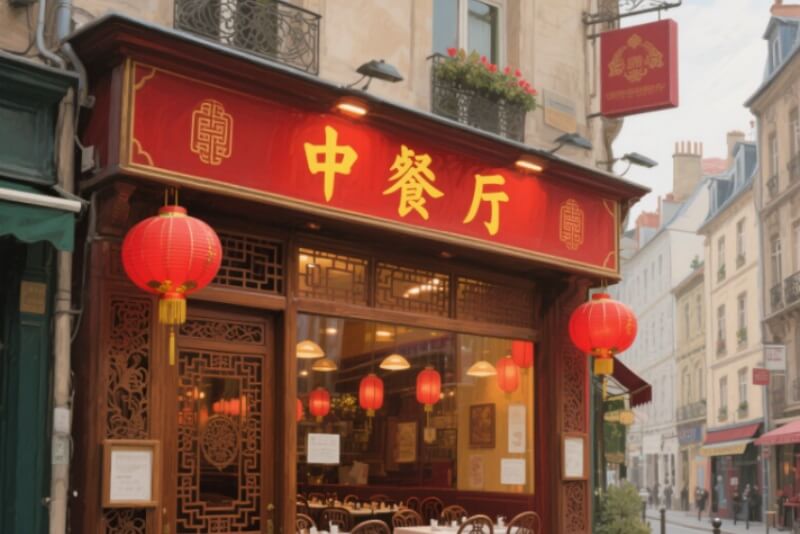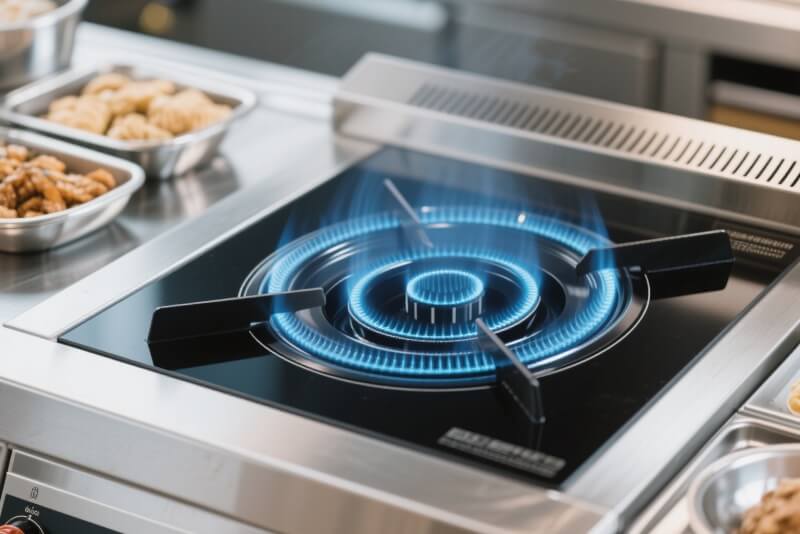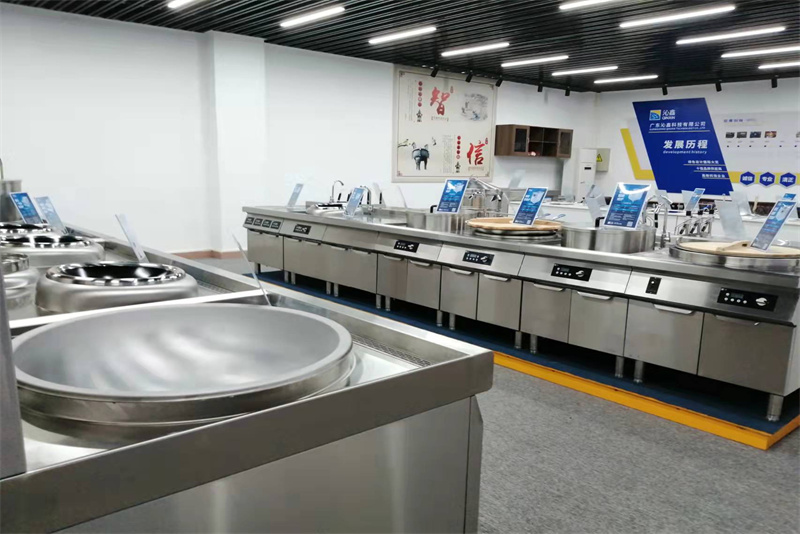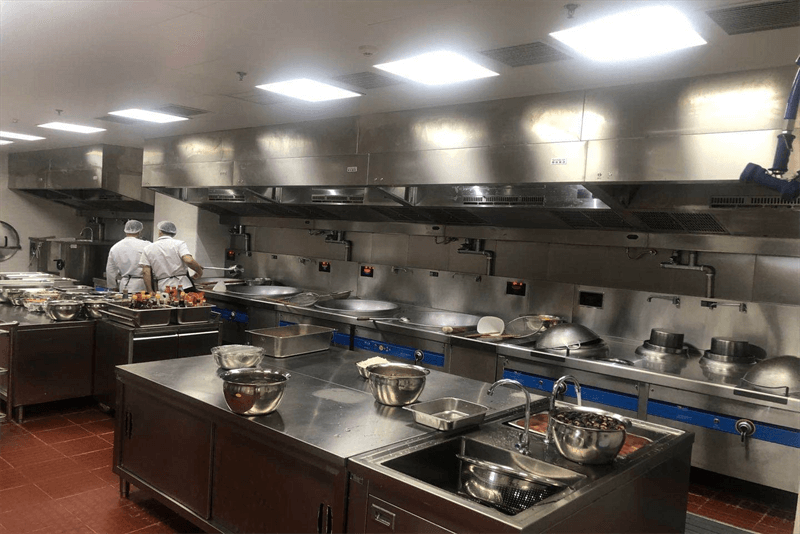Commercial induction cookers produce radiation, but the amount is relatively small and usually within a…

Opening a Chinese Restaurant in Europe? A Guide to Purchasing Commercial Cooking Equipment
Opening a Chinese restaurant in Europe presents many opportunities and challenges. To run the restaurant smoothly, the following are some guidelines on commercial cooking equipment selection, European commercial kitchen characteristics, fire and building regulations, and choosing the right cooking equipment according to European taste preferences.
I. Essential Commercial Cooking Equipment
1. Cooking Equipment
(1) Commercial Induction Cooker
It is one of the preferred cooking equipment for opening a European Chinese restaurant. The induction cooker uses the principle of electromagnetic induction to generate heat and has the advantages of fast heating speed, high efficiency, no open flame, and good safety performance.
It can accurately control the temperature and meet different dishes’ cooking needs. For example, when stir-frying dishes such as Kung Pao Chicken and Fish-flavored Shredded Pork, it can quickly heat up and lock in the nutrition and taste of the ingredients.
(2) Commercial Gas Stove
Although the gas supply in some parts of Europe may be subject to certain restrictions, gas stoves are still one of the commonly used equipment for many Chinese restaurant chefs, especially those who are good at using high heat to stir-fry. It uses natural gas or liquefied gas as fuel, has a high flame temperature, can quickly heat cooking utensils, and is suitable for cooking various Chinese dishes, such as stir-fried dishes. However, when using a gas stove, special attention should be paid to kitchen ventilation and gas leakage to ensure safety.
(3) Commercial Food Steamer
The steam generator heats water to generate steam and steam food, which can well preserve the nutrients and original flavor of the food.
When making pasta snacks such as buns, steamed buns, dim sum, and steamed seafood such as crabs and fish, the steamer can heat the pasta evenly, making the steamed product soft and retaining the freshness of the seafood to the greatest extent.
- Multi-purpose Steaming Oven
It integrates multiple functions such as steaming, baking, and baking, and can automatically adjust the temperature, humidity, and time according to different cooking procedures. For example, when making French baked snails, you can first use the baking function to make the surface of the snail golden and crispy, and then use the steaming function to keep the snail meat inside fresh and juicy. This equipment can provide restaurants with more diverse dish options.
(4) Commercial Baking Oven
Ordinary ovens generate heat through heating tubes, allowing food to be heated in a closed space. They can be used to bake various meats, vegetables, and baked goods, such as roast chicken, roast fish, roast vegetables, etc.
In bakeries, ordinary ovens can also be used to bake bread, such as baguettes and croissants. By controlling the temperature and time, the bread surface can form a beautiful golden, crispy crust, and the internal texture can be soft.
- Hot Air Circulation Oven
It adds a fan device to the ordinary oven, which can circulate hot air in the oven, allowing the food to be heated more evenly and shortening the cooking time. For example, when baking chicken wings, the hot air circulation oven can make all parts of the chicken wings evenly colored, with a crispy taste on the outside and tender on the inside.
(5) Commercial Deep Fryer
Deep-fried dishes are also common in Chinese restaurants, such as spring rolls, fried sauce, and fried meatballs. Ordinary electric fryers are suitable for small catering places. They heat the oil through electric heating, are easy to operate, and have convenient temperature control. Commercial deep fryers have a larger capacity and multiple frying baskets, which can fry a large amount of food at the same time. They also have precise oil temperature control and filtration systems, which can improve cooking efficiency and ensure the taste quality of food.
(6) Food Processing Equipment
Food processors such as vegetable cutters, slicers, meat grinders, and dough mixers can improve the efficiency and quality of food processing, reduce the time and labor intensity of manual operation, and ensure the consistency of food processing. They are very helpful for the preparation of a large number of ingredients and are indispensable auxiliary equipment for Chinese restaurants.
(7) Refrigeration Equipment
Including refrigerators, freezers, ice makers, etc., used to store fresh ingredients, beverages, and condiments, to maintain the freshness and taste of ingredients and ensure food safety. Commercial kitchens in Europe usually have high requirements for energy efficiency and the capacity of refrigeration equipment to meet the preservation needs of different ingredients.
(8) Dishwashers and Cleaning Equipment
Due to the high frequency of tableware use in Chinese restaurants, dishwashers are essential equipment that can efficiently wash tableware and ensure the hygiene and cleanliness of tableware. At the same time, appropriate cleaning tools and disinfection equipment are also needed to maintain the cleanliness and hygiene of the kitchen to strict European hygiene standards.
II. Characteristics of European Commercial Kitchens
1. Reasonable Space Planning
European commercial kitchens usually have spacious working areas and reasonable layouts to ensure smooth and efficient cooking processes. The kitchen will be divided into clear operating areas according to different cooking links and functions, such as food preparation area, cooking area, washing area, storage area, etc.
The various areas are independent of each other and closely connected, which is convenient for staff to divide the work and cooperate, improve work efficiency, and also help to keep the kitchen clean and hygienic.
2. Efficient and Durable Equipment
In order to meet the dining needs of a large number of customers and long-term continuous use, the equipment in European commercial kitchens usually has high performance and durability. Stoves, ovens, dishwashers, and other equipment are made of advanced technology and high-quality materials, can withstand high-intensity working pressure, and have a long service life and stable operating performance. At the same time, this equipment also focuses on energy saving and environmental protection performance to reduce operating costs and environmental impact.
3. Focus on Hygiene and Safety
Europe has extremely strict requirements on food safety and hygiene standards, and the design and equipment configuration of commercial kitchens fully reflect this. The kitchen floor, walls, and ceiling are usually made of easy-to-clean, wear-resistant, and waterproof materials, such as stainless steel and ceramic tiles, to facilitate daily cleaning and disinfection and prevent bacterial growth and cross-contamination.
The corners and interfaces of the equipment are designed to be smooth to avoid sanitary dead corners. At the same time, the kitchen is also equipped with a complete ventilation system, smoke exhaust equipment, and fire prevention facilities to ensure air circulation, fume emission, and fire safety, providing a healthy and safe environment for kitchen staff and customers.
-
 Portable Dual Basket Restaurant Induction Deep Fryer LT-TZL-B105
Portable Dual Basket Restaurant Induction Deep Fryer LT-TZL-B105 -
 Tabletop 2 Burners Restaurant Induction Wok Cooker LT-TPA-B135
Tabletop 2 Burners Restaurant Induction Wok Cooker LT-TPA-B135 -
 Tabletop 2 Burners Restaurant Induction Stovetop LT-TPP-B135
Tabletop 2 Burners Restaurant Induction Stovetop LT-TPP-B135 -
 Full Glass Commercial Drop-in Induction Cooktop LT-QPM-C335
Full Glass Commercial Drop-in Induction Cooktop LT-QPM-C335 -
 Tabletop Commercial Induction Cooktops 6 Burner LT-TBZ300VI-B135
Tabletop Commercial Induction Cooktops 6 Burner LT-TBZ300VI-B135 -
 5000W Countertop Restaurant Induction Wok Ranges LT-TAM-B505
5000W Countertop Restaurant Induction Wok Ranges LT-TAM-B505 -
 Restaurant Tabletop Induction Cooktop 3500W LT-TPM-B535
Restaurant Tabletop Induction Cooktop 3500W LT-TPM-B535 -
 3500W Commercial Countertop Induction Cooker LT-TPM-B135
3500W Commercial Countertop Induction Cooker LT-TPM-B135 -
 Tabletop 4 Burner Commercial Induction Hob 3500W LT-TBZ300IV-B135
Tabletop 4 Burner Commercial Induction Hob 3500W LT-TBZ300IV-B135
III. European Kitchen Fire Protection and Building Regulations
1. Fire Protection Regulations
(1) Fire Partition
The kitchen area must be effectively separated from other dining areas by fire protection. Fire walls, fire doors, and other facilities are usually used to divide different fire protection zones to prevent the spread of fire between the kitchen and other areas and ensure the safety of personnel evacuation routes.
(2) Fire Extinguishing Equipment
The kitchen must be equipped with a sufficient number of fire extinguishing equipment, such as fire extinguishers, fire blankets, automatic sprinkler fire extinguishing systems, etc., and regular inspections and maintenance must be carried out to ensure that this equipment can be used normally. In addition, the kitchen’s exhaust hoods and ventilation ducts are also prone to grease accumulation, and special fire extinguishing equipment needs to be installed to deal with possible grease fires.
(3) Alarm System
The installation of an automatic fire alarm system is one of the basic requirements of European kitchen fire protection regulations. The system can detect smoke, heat, or flames in time at the beginning of a fire and send out an alarm signal to remind kitchen staff and customers in the restaurant to take prompt action to evacuate and extinguish the fire to reduce the losses caused by the fire.
| Country | Key Requirement |
| Germany | The kitchen partition walls must meet the EI60 fire protection rating (fire resistance for 1 hour), and the exhaust hood must be cleaned monthly, and records must be kept. |
| France | All electrical circuits must be certified to BS EN 60335, and gas equipment must be installed by Gas Safe registered engineers. |
| UK | All electrical circuits must be certified to BS EN 60335 and gas equipment must be installed by Gas Safe registered engineers. |
2. Building Regulations
(1) Spatial Layout and Design
The architectural structure and spatial layout of the kitchen must comply with local building regulations, including the kitchen area, floor height, size, and location of ventilation openings, etc. The entrance and passage width of the kitchen must have sufficient space to meet the needs of personnel passage and equipment handling. At the same time, the setting of disabled access should also be considered to ensure that all personnel can easily enter and exit the kitchen.
(2) Material Selection
The building materials of the kitchen must meet the requirements of fire resistance, waterproofness, moisture resistance, and easy cleaning, such as the widespread use of stainless steel, tiles, and other materials mentioned above. In addition, there are certain requirements for the environmental performance of building materials to reduce the impact on indoor air quality and protect the health of kitchen staff and customers.
(3) Facility Installation and Acceptance
The various facilities and equipment in the kitchen, such as electrical systems, water supply and drainage systems, ventilation systems, etc., must be installed by professionals according to local building specifications and standards, and must pass the acceptance of relevant departments after installation to ensure the safety and reliability of the facilities.
(4) Key Points of Building Compliance
The smoke exhaust system must meet the EN 16282 standard, and the exhaust volume is calculated as ≥50m³/h per square meter of kitchen area. Commercial refrigerators (full load up to 800kg) need to be laid on a reinforced floor (load bearing ≥1500kg/m²). The EU stipulates that the width of the main kitchen passage is ≥1.2 meters and the door frame is ≥0.9 meters.
IV. Europeans’ Taste Preferences and Cooking Equipment Selection
1. Taste Characteristics
Europeans have relatively light tastes, pay attention to the original flavor of ingredients, prefer cooking methods such as boiling, steaming, baking, and frying, and have a low acceptance of greasy and spicy foods.
They like to eat a variety of meats, seafood, vegetables, fruits, and dairy products and make them into salads, soups, stews, barbecues, grilled fish, pasta, pizza, and other dishes.
| Region | Preferred flavor | Popular dishes | Recommended Equipment |
| Northern Europe | Light, low in oil, and high in protein. | Steamed sea bass, garlic broccoli | Commercial Food Steamer |
| Southern Europe | Sweet and sour, slightly spicy | Sweet and Sour Pork, Black Pepper Beef Fillet | Commercial Induction Griddle |
| UK | Crispy Food | Spring rolls, sesame chicken | Double Tank Commercial Fryer |
| Central and Eastern Europe | Rich Sauce | Braised pork, Beijing-style pork shreds | Commercial Stew Cooker |
In addition, Europeans also have certain requirements for the taste of food. They like dishes that are crispy on the outside and tender on the inside, fresh and juicy. They also have high demands for desserts and coffee.
V. Purchase Commercial Induction Cooking Equipment
1. Advantages of Commercial Induction Cookers
| Contrast | Induction Cooker | Gas Stove |
| Thermal Efficiency | >90% | 40% to 50% |
| Startup Speed | 1 to 2 minutes warm-up | 1 to 2 minutes warm-up |
| Safety Factor | No open flame cooking, automatic power off | Risk of gas leaks |
| Compliance costs | Soft towel to wipe | Cleaning after disassembly of the burner |
| Service life | 8 to 10 years | 5 to 8 years |
2. Core Equipment List and Budget
| Equipment | Model | Power | Price | Application |
| Commercial Wok Cooker | LT-X400II-E108Y | 15KW | €2000 – 4500 | Stir-frying |
| Commercial Soup Cooker | LT-P420II-E115 | 15KW | €2000 – 3000 | Boiling Soup / Hot pot sauce |
| Commercial Steaming Baking Oven | LT-WZ6-G119 | 19KW | €5000 – 6500 | Dim sum, steaming fish, and roasted duck |
| Induction Food Warmer | LT-QPM-C135 | 3.5KW | €250 – 500 | Buffet |
Total investment recommendation: Small and medium-sized restaurants (80 seats) require about €40,000-60,000, of which 30%-50% can be covered by EU SME subsidies (such as German KfW loans).
Summary
When opening a Chinese restaurant in Europe, the key factors for success are to choose commercial cooking equipment reasonably, understand the characteristics and regulatory requirements of local commercial kitchens, and adjust equipment configuration and dishes according to European taste preferences.
Induction cooking equipment has become one of the ideal choices for opening Chinese restaurants in Europe, with its advantages of high efficiency, safety, energy saving, and environmental protection.
automatic cooking machine automatic cooking machines bbq chip fryer commercial cooking equipment commercial drop in induction cooker commercial food steamer commercial induction cooker commercial induction cooktop commercial induction deep fryer commercial induction fryer commercial induction hob commercial induction soup cooker Commercial Induction Steamer Cooker commercial induction wok cooker commercial kitchen cookware food steamer hob induction cooker induction cookware INDUCTION FRYER induction grill induction hob iron wok kitchen equipment repair guide restaurangt equipment restaurant equipment stainless steel cookware user's guidance



This Post Has 0 Comments